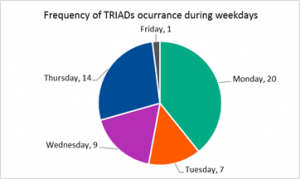Here is a fun fact for you, in the same time that it takes you to watch the latest blockbuster or cook the Sunday roast (roughly 90 minutes), your organisation would have accumulated around 5% of its annual electricity cost. This time is known as the Triad period and if you are not already aware of it or taking steps to deal with it then we suggest that you continue reading.
What are Triads?
Defined as the 90 minutes of highest demand, Triads are actually made up of the three separate time periods (separated by at least 10 clear days either side) in which the UK energy grid experiences its highest demand between November and February each year. This period is when days are shorter and temperatures drop which causes people to turn on the heating and lights causing demand to rise. During a Triad, kilowatt units are charged at a considerably higher rate than normal which is why the advice has always been to try and avoid them.
Why do they exist?
The Triad system exists for two main reasons. Firstly Triad charges are used to help calculate the annual transmission costs for Half Hourly (HH) energy users. Using the three highest energy peaks as the basis for the annual transmission cost works out to the best solution for HH organisation. The alternative pricing structure, used for Non-Half Hourly users (NHH), which sets a lower unit rate but charges for all units used throughout the year between 4pm & 7pm would be crippling for most HH organisations.
The other benefit of this system is that it presents HH users with the possibility of avoiding transmission costs all together. In theory, if HH users don’t consume energy during the Triad period then they can’t be charged. This has the additional benefit of reducing demand during peak times which eases pressure on the National Grid.
How do they impact organisations?
As we have already established, Triads add to the overall transmission cost of electricity consumption. In 2005 HH users didn’t really notice Triads as they were set at 4p/kW which was comparatively low compared with their standard kW unit cost. Unfortunately this is no longer the case as Triad charges throughout the North of Scotland have increased and are expected to be over £50/kW in the years to come. This is why ignoring Triads can be costly to your organisation.
How can businesses predict them?
First things first Triads are not unavoidable, which used to be the old way of thinking, however the current complexity of the market makes them very difficult to predict. Having analysed all Triad events since the 21st Century (51 in total), we have found the following:
The most likely time of year for a Triad to occur is during December and January
The most common day for a TRIAD has been a Monday followed Thursday
The majority of the Triads have occurred between 17:00 to 17:30
We have added some graphs below which gives more analysis regarding historic Triad periods.




